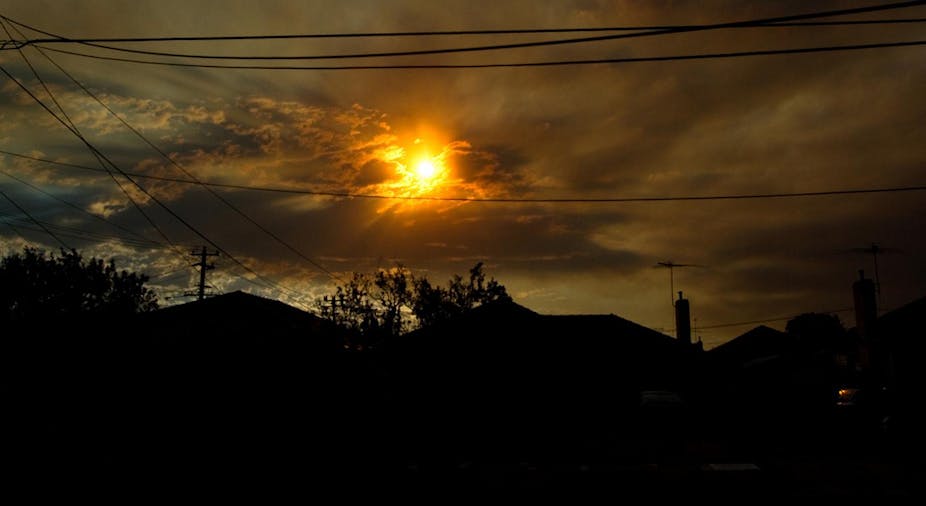We have unwittingly hardwired a bushfire ignition source throughout our flammable landscapes – powerlines. Powerlines can fail under any conditions but the risk increases on days of high bushfire risk, which means powerline failures frequently start bushfires.
The problem was clearly identified by the 2009 Black Saturday Victorian Bushfire Royal Commission. The Director of Energy Safe Victoria told the Commission it was “probably self-evident” that there was an increased chance of fires caused by electrical assets on days of extreme fire danger.
The Bushfire Royal Commission found that on 7 February 2009, electrical faults caused five of the 11 major fires.
This significant risk led the Royal Commission to make a number of recommendations. These are now being acted on as part of the Victorian Government’s Powerline Bushfire Safety Program. More than $750 million is being invested in new safety measures for Victoria’s electricity grid. Changes include improved maintenance of existing infrastructure and roll out of technology to target high risk areas.
This requires approximately $500 million in improvements to protection and controls on Victoria’s electricity network. These “will be funded by electricity distributors and will be recovered at a modest increase in power bills to customers.” The Victorian Government will “provide up to $200 million for the replacement of powerlines in areas of highest bushfire risk over the next eight years”. There will be an additional $40 million Safer Electricity Assets Fund “to address equity and financial hardship issues associated with bushfire mitigation”. Ten million dollars will be provided “to fund research to improve the cost effectiveness of bushfire mitigation”.
A key change in existing infrastructure is the modification of automatic circuit breakers. The current generation of circuit breakers has been shown to cause bushfires by sparking when attempting to reconnect power. However modifications to remedy this fault may result in blackouts on days of high bushfire risk.
Bushfire ignition by power line faults has a serious legal dimension. Powercor paid Horsham residents and businesses $40 million to settle a class action after the Black Saturday bushfires. The electricity provider SP AusNet paid $19.7 million to settle a class action over the Beechworth fire that also occurred on Black Saturday. The company is contesting other class actions relating to other Black Saturday bushfires, all allegedly caused by electrical faults.

Improving the maintenance and quality of powerline infrastructure is a direct consequence of the Bushfire Royal Commission. An unforeseen response is the practice of actively shutting down power distribution systems. Earlier this year there was an extreme heat wave in South Australia. Power distributor Electricity Trust of South Australia cut electricity to some communities to prevent bushfires.
Likewise, Tasmanian electricity provider Aurora Energy signalled it might cut power during times of extreme fire weather conditions. Electrical providers offer guidance for coping with power outages including recommending consumers consider installing their own back up generators.
The consequences of imposed blackouts raise a problem that has received little consideration. During days of extreme bushfire danger, the associated high temperature presents a substantial public health risk. Heatwaves are a significant cause of death and with climate change it is predicted that this rate will sharply rise.
Climate change is likely to bring more frequent extreme fire weather that poses risks from both bushfire and heat stress. The interplay between bushfire risk, power supplies and extreme weather illustrates what actual adaptation to climate change will look like. This is not a passive or painless process.
Improved maintenance and infrastructure will necessarily oblige power distribution companies to increase power prices or seek subsidies from government. The risk of litigation will lead to more power outages designed to avoid setting bushfires. Surviving blackouts will be then be consumers’ responsibility.
Legal action from people affected by severe heat stress during power outages could possibly follow prolonged blackouts designed to avoid bushfires. Without care, a difficult situation could spiral out of control. The legal blame game is a poor way of adapting to climate change.
The trick is finding a solution that can balance the costs and risks of managing power supplies in flammable landscapes. This first step is for everyone to understand that we all have a stake in the problems created by climate change.

